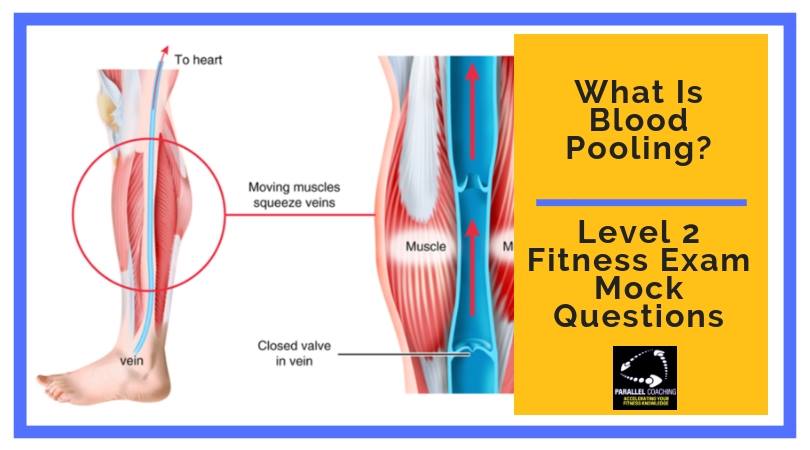This blog will teach you all about Blood Pooling in preparation for your Level 2 Fitness Exams.
You’ll discover:
- What blood pooling is
- What is Venous Return?
- Key Symptoms associated with Blood Pooling
- Key Causes of Blood Pooling in Exercise
- Why you need to know about Blood Pooling ready for your Level 2 Fitness Exam
- An Example Mock Question about Blood Pooling
What is blood pooling?
Blood pooling is a condition where blood gathers in the lower limb (legs) for a number of reasons including exercise.
When blood gathers in a blood vessel it places excess stress on the small non-return valves that prevent the blood from being drawn back down to the feet due to the effect of gravity.
These non-return valves in the veins have an important part to play in ensuring that blood returns to the heart effectively.
This is called venous return.

Said differently…
While the heart pumps blood through the arteries, the veins depend on muscles contracting (squeezing) to move blood upward to the heart.
Valves in the veins keep blood from flowing backward.
The image above shows that when leg muscles contract they squeeze the veins and push the blood back towards the heart.
The image also shows that veins have valves that prevent the back-flow of blood. These are like the valves in the siphon pumps. They let fluid pass in one direction only.
The Causes of Blood Pooling
In terms of exercise, if you have been working at an intensive level and fail to cool down effectively, this will result in the build-up of blood in the limbs.
It is advised that you do some form of rhythmical exercise for 3 to 5 minutes at a low intensity with the aim of lowering the heart rate to 110bom or below.
This allows the various systems of the body to return the blood back to the heart.
This can also be aided by a full stretching routine and partner stretches can be great for this as gravity will help to return the blood back to the heart.
The Symptoms of Blood Pooling
During Blood Pooling the blood stays in the lower limbs, this means the heart may not fill before each contraction, this often leads to a dizzy and faint feeling.
Your vision may blur and you may start to sweat. You can feel cold or clammy and may not think straight.
For these reasons, it is very important that you take part in a full structured cooldown appropriate to the session.
Strenuous exercise can increase the amount of blood the heart pumps out from 5 litres (1.3 gallons) per minute to 30 litres (8 gallons) per minute.
Blood Pooling will come up in your Level 2 anatomy and physiology exam, You can learn everything about The Heart and Circulatory System in this FREE Video training
Why is blood pooling included in your Level 2 Anatomy and Physiology Exam?
Having knowledge of this will allow you to gain a greater understanding of safe and effective client sessions.
Applying this understanding of blood pooling to your session planning means that your clients are less likely to feel dizzy, sick or unwell on your sessions.
Which means they leave your session feeling great and ready to come back next time.
In summary
- Blood pooling is a condition where blood gathers in the lower limb
- The non-return valves in the veins have an important part to play in ensuring that blood returns to the heart effectively.
- This often leads to a dizzy and faint feeling.
- A full structured cool down is key to avoiding dizziness
- Here’s what Karen had to say about the A&P Revision Bootcamp 👇 👇 👇
Fantastic content that is easy to use and helps breakdown complex subjects into an easy to learn format. The team is Super professional yet so friendly and engaging. I look forward to my daily questions and videos. Keep up the amazing work!
Karen Bushnell
Test your knowledge with three mock questions:
[NOTE: The answers are below the 3rd question]
Q1: Which of the following is a direct symptom of blood pooling following sudden cessation of intense exercise?
A. Heart arrhythmias
B. High blood pressure
C. Dizziness/feeling faint
D. Hyperventilation
Q2: What is venous return?
A. The delivery of blood flow to the muscles
B. The return of blood flow back to the heart
C. Heart rate
D. Breathing rate
Q3: When is blood pooling most likely?
A. Stopping exercise whilst the heart rate is still high
B. Achieving high heart rates with a thorough warm-up and cool down
C. During strenuous resistance training
D. Standing up too quickly
Answers to the mock questions are :
Question 1= C, Question 2 = B, Question 3 = A
If you want more mock questions like this, then you can download more Free Mock Questions: DOWNLOAD NOW
Need More Help with your Level 3 Anatomy Revision?
For Trainee FITPROS Taking Their L3 Anatomy & Physiology Exam.
Learn, Revise & Pass Your Level 3 Anatomy & Physiology Exam In Under 10-hours
(Without Having To Spend Hours Revising Or Feeling Overwhelmed)
If you want to get your revision structured, learn everything you need to know, and feel confident on exam day, then click the link below:

Dedicated to More
Hayley “What Is Blood Pooling” Bergman
Parallel Coaching
P.S. You can also find us on the following platforms:
Instagram: Follow Now
Facebook: Like Our Page
Twitter: Tweet Us
YouTube: Subscribe Here
More Circulatory System Blogs: HERE

